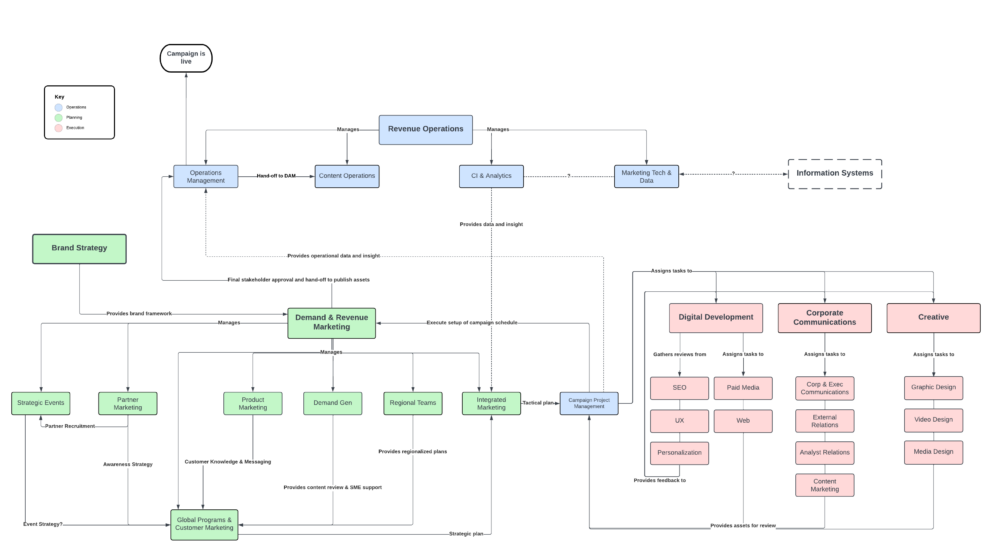“MOVE: The 4-Question Go-to-Market Framework” – A Summary of Sections 1 and 2

Summary
This blog post details some of the takeaways from the first two sections of Sangram Vajre and Bryan Brown's "MOVE Framework", teaching business leaders the questions they need to ask when reimagining scaling their go-to-market initiatives. This blog post will be followed by an additional blog next month, covering the latter three sections. The first two sections cover defining GTM, the truths of scaling GTM, and how to determine where your business may be on the GTM Maturity Curve.
By Sarah Threet, Marketing Consultant at Heinz Marketing
At Heinz Marketing, we value continuous improvement and growth and we care about being in-the-know about the latest marketing strategies and best practices so we can deliver the best work to our clients. Recently, we read Sangram Vajre and Bryan Brown’s book “MOVE: The 4-Question Go-to-Market Framework” and we really resonated with the questions being asked in their assessment of where a company currently sits in their go-to-market strategy. There are takeaways from this book that we are likely to incorporate in our own consulting, therefore we wanted to share it in a couple of blogs. This blog goes over Sections 1 and 2 (predominantly section 2); my colleague will follow up with a blog on Sections 3-5.
What is Go-to-Market?
Part of why go-to-market (GTM) resonates with our consultants is because as our team seeks continuous improvement, this framework relies on the same kind of mindset: ongoing transformation and continued growth. Frequently businesses fail to take their dream from ideation to proper execution. It can be difficult to know what the right next move is in your company’s growth. GTM illustrates a practical path that aligns all your stakeholders to your vision and navigates your company through the three stages of GTM growth.
Go-to-market isn’t a strategy nor is it a project. It is a “transformational process for accelerating your path to market with high-performing revenue teams delivering a connected customer experience”. This process is intended to create and iterate a process that is repeatable and scalable, enables all stakeholders to work together, and recognizes the customer at every touch point in the buying process. GTM serves as the vehicle that delivers and aligns the company’s strategy (purpose and dreams) with customer outcomes (benefits realized).
The 6 Truths of GTM
Before I dive into the second section of the book about the GTM Maturity Curve, I want to stress that you should go read this book in its entirety. It’s important to have to appropriate context, as GTM is a framework and is not intended to be used as a strategy; it’s an iterative process. Vajre and Brown dive deep into “6 Truths” about the framework to align readers to this mindset; here’s a summary of that section:
Truth 1: GTM is like building a new product – and like a product, it will be improved upon over time with customer data and input. Treating GTM more like a product than a project will encourage your company to continue to invest in it like it would a product.
Truth 2: Revenue teams have a new roommate – customer success. GTM is about creating high-performing revenue teams that connect marketing, sales, and customer success. If you have difficulty aligning your sales and marketing teams, GTM is not going to be a framework you can successfully implement, as you’re going to need to align a third team, customer success, as well.
Truth 3: Small is the new big – instead of trying to reach everyone in the biggest possible market (total addressable market), focus on the customers most relevant to your product (total relevant market).
Truth 4: RevOps is the new growth lever – without standardized, accurate, holistic data, from a single source of truth, a company cannot make strategic decisions. Attribution cannot be defined differently by each group; marketing, sales, and customer success cannot come to the table with different data and argue whose is more correct, so you need a “truth teller” (RevOPs) to manage and organize your data.
Truth 5: Retention is the new acquisition – it is five times more expensive to acquire a new customer than it is to retain one, so focus your GTM process on working to increase customer lifetime value and grow the value of your existing customers.
Truth 6: Flywheels are the new funnels – according to Forrester, less than 1% of leads from a lead funnel will become loyal customers, so focus more on quality over quantity or else you’ll have a wasteful churn machine.
The GTM Maturity Curve
To better understand where you’re going with your GTM process, you’ll need to first understand where you currently sit on the GTM maturity curve. As defined by Vajre and Brown, there are three stages and three “P’s” to the GTM business transformation:
- Ideation (problem-market fit): lead-focused, sales-led, inefficient growth
- Transition (product-market fit): account-focused, sales-marketing alignment, efficient growth
- Execution (platform-market fit): customer-focused, integrated revenue team, efficient growth at scale
Revenue is not the material indicator of what stage your company is in; it depends a lot on the dynamics of your industry, market, category, and offering.
Ideation Stage: This is the stage at which you don’t yet have a fully developed product offering and are unsure of its fit in the market or whether or not it addresses a problem in the market.
Transition Stage: This is the stage at which you have the right product for the right market, and you are confident that it will provide the best solution for your ideal customer profile. At this stage, the sales team now needs a repeatable, scalable process to assist in selling more of the product and grabbing a larger piece of the market.
Execution Stage: This is the stage at which you have become successful with one product offering and are ready to become a multiproduct company. As you move out of a single market, and your personas become more diverse and have nuanced and niche needs, you will want a whole suite of products to address these problems; your focus then shifts from product to platform.
Vajre and Brown make it very clear that they expect the CEO to own the GTM process (not marketing). The CEO needs to keep all stakeholders aligned to keep the GTM process well-oiled. They are the person who should know best what stage the company currently sits in, and when and how to appropriately grow to the next stage.
From Ideation to Transition
When you’re in the ideation stage, it is understandable to be focused on leads, as you do not yet have enough information about your ideal customer profile – it remains undefined. As your sales team calls leads, they will accrue knowledge that can be translated into data to help inform what the common problems are in the market. Eventually, gathering leads brings a low return and becomes expensive and inefficient.
To get to the Transition stage, the GTM team needs to have leaders focused on new metrics, shifting from funnel conversions and cost-per-lead to pipeline coverage, customer acquisition costs (CAC), and gross revenue retention, ideally broken out by segment performance. At this point, you will need to also align your sales and marketing teams, as during the Ideation stage, they are still learning and not yet informed on the metrics and segments to focus on.
This transformation can often take a while, as it requires research, patience, diligence, and alignment of goals, people, and metrics. If you’re having trouble getting out of Ideation and into Transition, Vajre and Brown recommend evaluating the following:
- Have you found your ideal customer for your product yet?
- Are you relying too heavily on discounting for adoption?
- Is your brand’s positioning strong?
- Do you understand why you are experiencing high levels of churn?
- Do customers feel like they understand and see the ROI of the product by renewal time?
- Are you honestly delivering what you are selling?
- Are you relying on heroics over repeatability in your sales team to make wins?
From Transition to Execution
If your product addresses a problem and your GTM process focuses on quality acquisition using segmentation, and you have happy customers with growing CLVs, then you may be ready to transition to the Execution stage wherein you address multiple nuanced issues with more product offerings on a repeatable and scalable platform.
Your efforts may be decentralized still as you begin to consider expansion. If you’re having trouble moving from Transition to Execution, Vajre and Brown recommend evaluating the following:
- Are you still too focused on only a singular product offering?
- Have you properly invested in the distribution required for future revenue growth?
- Are you able to predict how to hit your metrics?
- Are your second and third products stand-alone or more like features of the first product?
- Are you second and third products taking flight? What is misaligned if they are not?
- Are you dominating any area or are you trying to compete on multiple fronts while owning none?
- Are your teams adequately equipped and understand their role in execution?
To summarize
Your company is in the Ideation stage if it is generally undefined, be that GTM does not exist, the operational aspects are inefficient, and/or that business performance is inconsistent.
You may be in the Transition stage if your business is better defined; GTM may now be defined, and marketing strategy may exist, but it may not be serving as the glue to your organization. In this stage, you should start having consistent measurement, execution and results across GTM initiatives, and supporting functions.
If you’re on your way to the Execution stage, your company’s GTM is defined, aligned, and reasonably operationalized, and respective GTM functions have measurable initiatives to which they are accountable. In this stage, execution and results are not only repeatable, but forecasting of the business should be predictable, and a strong indicator of the predictability is if the company has hit or exceeded their plan for three quarters straight.
We highly recommend checking out this book, and you can expect a summary of the following three sections in our blog next month!






